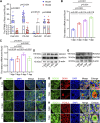ROCK1 is a multifunctional factor maintaining the primordial follicle reserve and follicular development in mice
- PMID: 37661919
- PMCID: PMC11192470
- DOI: 10.1152/ajpcell.00019.2023
ROCK1 is a multifunctional factor maintaining the primordial follicle reserve and follicular development in mice
Abstract
The follicle is the basic structural and functional unit of the ovary in female mammals. The excessive depletion of follicles will lead to diminished ovarian reserve or even premature ovarian failure, resulting in diminished ovarian oogenesis and endocrine function. Excessive follicular depletion is mainly due to loss of primordial follicles. Our analysis of published human ovarian single-cell sequencing results by others revealed a significant increase in rho-associated protein kinase 1 (ROCK1) expression during primordial follicle development. However, the role of ROCK1 in primordial follicle development and maintenance is not clear. This study revealed a gradual increase in ROCK1 expression during primordial follicle activation. Inhibition of ROCK1 resulted in reduced primordial follicle activation, decreased follicular reserve, and delayed development of growing follicles. This effect may be achieved through the HIPPO pathway. The present study indicates that ROCK1 is a key molecule for primordial follicular reserve and follicular development.NEW & NOTEWORTHY ROCK1, one of the Rho GTPases, plays an important role in primordial follicle reserve and follicular development. ROCK1 was primarily expressed in the cytoplasm of oocytes and granulosa cell in mice. Inhibition of ROCK1 significantly reduced the primordial follicle reserve and delayed growing follicle development. ROCK1 regulates primordial follicular reserve and follicle development through the HIPPO signaling pathway. These findings shed new lights on the physiology of sustaining female reproduction.
Keywords: HIPPO; ROCK1; follicular development; ovary; primordial follicle reserve.
Conflict of interest statement
No conflicts of interest, financial or otherwise, are declared by the authors.
Figures









Similar articles
-
The role of KAT6A in regulating primordial follicle activation in mouse ovary.Am J Physiol Cell Physiol. 2025 Jul 1;329(1):C38-C49. doi: 10.1152/ajpcell.00055.2025. Epub 2025 May 28. Am J Physiol Cell Physiol. 2025. PMID: 40434042
-
Dynamics of PI3K and Hippo signaling pathways during in vitro human follicle activation.Hum Reprod. 2018 Sep 1;33(9):1705-1714. doi: 10.1093/humrep/dey250. Hum Reprod. 2018. PMID: 30032281
-
The infant and pubertal human ovary: Balbiani's body-associated VASA expression, immunohistochemical detection of apoptosis-related BCL2 and BAX proteins, and DNA fragmentation.Hum Reprod. 2013 Mar;28(3):698-706. doi: 10.1093/humrep/des453. Epub 2013 Jan 12. Hum Reprod. 2013. PMID: 23315064
-
The dynamics of the primordial follicle reserve.Reproduction. 2013 Oct 21;146(6):R205-15. doi: 10.1530/REP-13-0181. Print 2013 Dec. Reproduction. 2013. PMID: 23929903 Review.
-
Cellular and molecular regulation of the activation of mammalian primordial follicles: somatic cells initiate follicle activation in adulthood.Hum Reprod Update. 2015 Nov-Dec;21(6):779-86. doi: 10.1093/humupd/dmv037. Epub 2015 Jul 30. Hum Reprod Update. 2015. PMID: 26231759 Review.
Cited by
-
Theophylline derivatives promote primordial follicle activation via cAMP-PI3K/Akt pathway and ameliorate fertility deficits in naturally aged mice.Int J Biol Sci. 2024 Sep 30;20(13):5312-5329. doi: 10.7150/ijbs.99936. eCollection 2024. Int J Biol Sci. 2024. PMID: 39430241 Free PMC article.
-
Oocytes maintain low ROS levels to support the dormancy of primordial follicles.Aging Cell. 2025 Jan;24(1):e14338. doi: 10.1111/acel.14338. Epub 2024 Sep 19. Aging Cell. 2025. PMID: 39297300 Free PMC article.
-
HDAC6-dependent deacetylation of NGF dictates its ubiquitination and maintains primordial follicle dormancy.Theranostics. 2024 Mar 25;14(6):2345-2366. doi: 10.7150/thno.95164. eCollection 2024. Theranostics. 2024. PMID: 38646645 Free PMC article.
-
Berberine promotes primordial follicle activation and increases ovulated oocyte quantity in aged mice.Mol Med. 2024 Dec 20;30(1):251. doi: 10.1186/s10020-024-01042-z. Mol Med. 2024. PMID: 39707173 Free PMC article.
References
-
- Qin X, Gong Y, Yu F, Song J, Dong S, Zhang R, Zhang J. A comparison of the efficacy and safety of traditional Chinese medicine in preconditioning patients with diminished ovarian reserve that would undergo In Vitro fertilization: a network meta-analysis protocol. Medicine (Baltimore) 100: e24408, 2021. doi:10.1097/MD.0000000000024408. - DOI - PMC - PubMed
-
- Zhang H, Panula S, Petropoulos S, Edsgärd D, Busayavalasa K, Liu L, Li X, Risal S, Shen Y, Shao J, Liu M, Li S, Zhang D, Zhang X, Gerner RR, Sheikhi M, Damdimopoulou P, Sandberg R, Douagi I, Gustafsson J-Å, Liu L, Lanner F, Hovatta O, Liu K. Adult human and mouse ovaries lack DDX4-expressing functional oogonial stem cells. Nat Med 21: 1116–1118, 2015. doi:10.1038/nm.3775. - DOI - PubMed
Publication types
MeSH terms
Substances
Grants and funding
LinkOut - more resources
Full Text Sources

